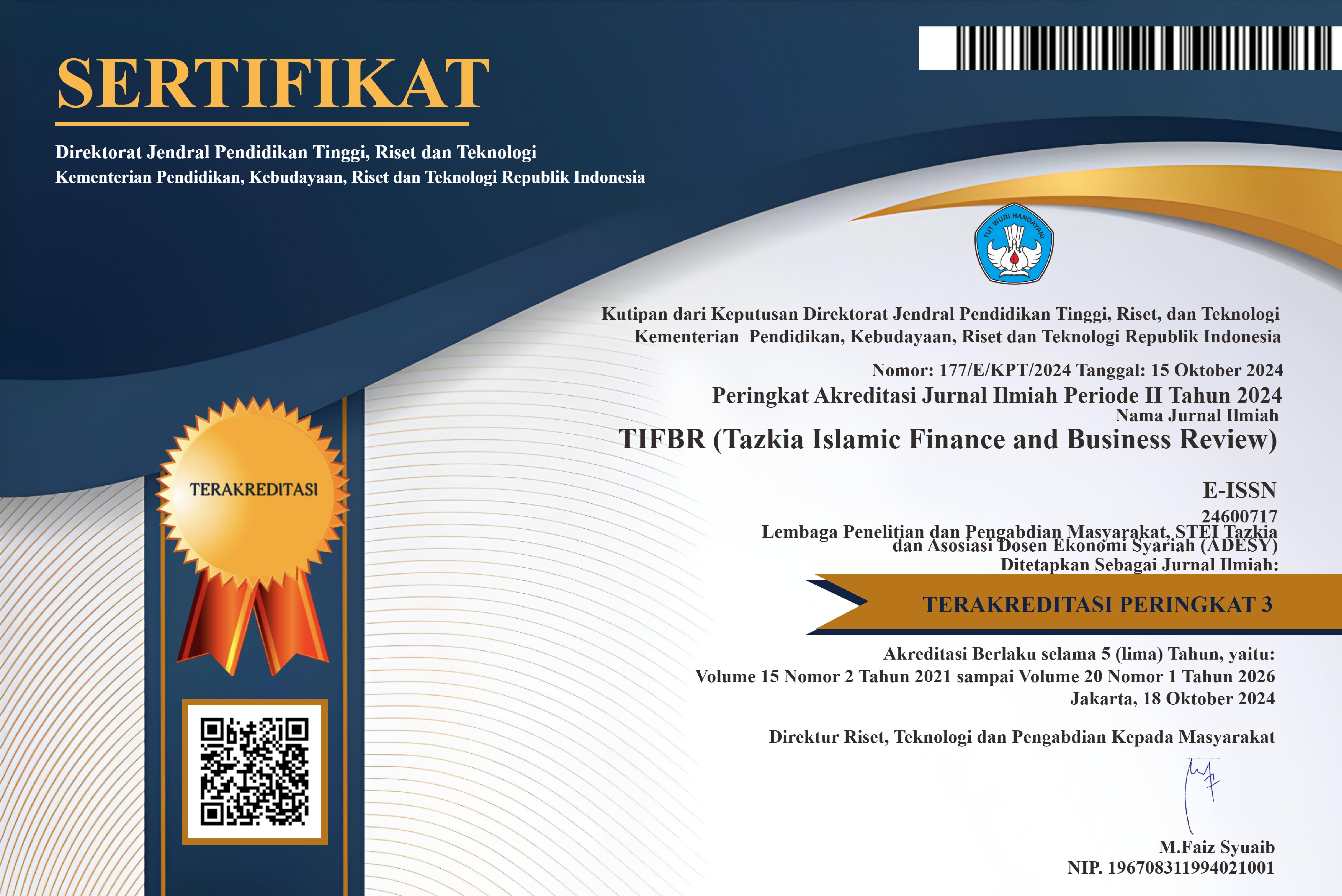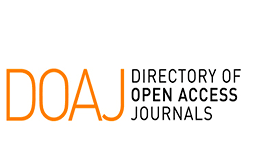THE EFFECT OF MAQĀṢID-BASED DEVELOPMENT VARIABLES ON ECONOMIC GROWTH BASED ON UMER CHAPRA’S PERSPECTIVE (CASE STUDY: NINE SELECTED OIC COUNTRIES)
DOI:
https://doi.org/10.30993/tifbr.v9i2.94Keywords:
Human Development, Maqāṣid Variables of Umer Chapra, Economic Growth, OICAbstract
Objectives: Human Development Index (HDI) has multidimensional aspects of life. In fact, HDI measures only physical aspects that are needed by human such as education, health and wealth. Accordingly, discussing on human must cover material, physical and spiritual aspects. Maqāṣid is needed as a wasilah (medium) to promote the benefit of human (maslahat), which contains of daruriyyat, hajiyat and tahsiniyat. By then, this study aims to analyze maqāṣid based development variables of Umer Chapra perspective on economic growth in 9 selected OIC member countries.
Method: The methodology of the study used mixed methods: qualitative and quantitative. The quantitative applies panel data regression analysis with 9 selected OIC countries (Indonesia, Jordan, Kazakhstan, Kyrgyzstan, Mesir, Pakistan, Togo, Turkey and Uzbekistan) with time series from 2004 to 2013. For qualitative applies content analysis approach by using tafsir of Ibnu Katsir.
Results: The finding shows that all independent variables, which are literacy rate, enrollment of school, poverty rate, gini index, life expectancy at birth, rule of law and voice accountability have significant effect on economic growth in 9 selected OIC member countries, both simultaneously and individually.
Conclusion: This study concludes that HDI which is bounded by maqāṣid approach affects on increasing of economic growth in 9 of OIC member countries significantly.References
Ad- Dimasyqi, A. (2001). Tafsir Ibn Katsir Juz 5. Translated by Bakr, Abu Bahrun. Sinar Baru Algensindo: Bandung. First mold. Pp.chapra 36- 43.
Ad- Dimasyqi, A. (2001). Tafsir Ibnu Katsir Juz 6. Translated by Bakr, Abu Bahrun. Sinar Baru Algensindo: Bandung. First mold. Pp. 173- 174 and 388- 396.
Ad- Dimasyqi, A. (2002). Tafsir Ibnu Katsir Juz 8. Translated by Bakr, Abu Bahrun. Sinar Baru Algensindo: Bandung. First mold. Pp. 287- 292.
Ad- Dimasyqi, A. (2003). Tafsir Ibnu Katsir Juz 14. Translated by Bakr, Abu Bahrun. Sinar Baru Algensindo: Bandung. First mold. Pp. 237- 244.
Alu Syaikh, Dr. 'A. (2008). Tafsir Ibnu Katsir Volume 4. Translated by Ghoffar, M. 'Abd and al Atsari, Abu Ihsan. Edited by Aaron M. Yusuf et al. Pustaka Imam Asy- Syafi'i: Jakarta. First mold. Pp. 91- 93.
Alu Syaikh, Dr. 'A. (2008). Tafsir Ibnu Katsir Volume 6. Translated by Ghoffar, M. 'Abd and al Atsari, Abu Ihsan. Edited by Aaron M. Yusuf et al. Pustaka Imam Asy-Syafi'i: Jakarta. First mold. Pp. 255- 260 and 535- 536.
Alu Syaikh, Dr. 'A. (2008). Tafsir Ibnu Katsir Volume 7. Translated by Ghoffar, M. 'Abd and al Atsari, Abu Ihsan. Edited by Aaron M. Yusuf et al. Pustaka Imam Asy- Syafi'i: Jakarta. First mold. Pp. 170- 171 and 209- 210.
Alu Syaikh, Dr. 'A (2008). Tafsir Ibnu Katsir Volume 8. Translated by Ghoffar, M. 'Abd and al Atsari, Abu Ihsan. Edited by Aaron M. Yusuf et al. Pustaka Imam Asy- Syafi'i: Jakarta. First mold. Pp. 132 and 221-227.
Alu Syaikh, Dr. 'A (2008). Tafsir Ibnu Katsir Volume 9. Translated by Ghoffar, M. 'Abd and al Atsari, Abu Ihsan. Edited by Aaron M. Yusuf et al. Pustaka Imam Asy-Syafi'i: Jakarta. First mold. Pp. 131-135, 248- 249, 447-450, 540-541, 365-368.
Amin, R, et al. (2012). The Integrated Development Index (I-DEX): A New Comprehensive Approach to Measuring Human Development.
Central Bureau of Statistics. (2015). The Concept of Human Development. http//www.bps.go.id.
Beverly, S G and Sherraden, M. (1997). Investment in Human Development as a Social Development Strategy. Social Development Issues, 19 (1), 1-18. Central for Social Development. Washington University.
Chambers, R. (1983). Rural Development: Putting the Last First. United States of America: Longman Inc. p. 111.
Chapra, M U et al. (2008). The Islamic Vision of Development in The Light of The Maqāshid al Shariah. Islamic Economic Studies. Jeddah, Kingdom of Saudi Arabia: Islamic Research and Training Institute, Islamic Development Bank.
Deneulin, S and Alkire, S. (2009). The Human Development and Capability Approach in an Introduction to the Human Development and Capability Approach. Edited by Deneulin, S and Shahani, L. ISBN 978-1-55250-470-3. p. 23: UK dan USA.
Esen, M. F. (T, th). Indentification and Classification of Maqāshid Al- Shariah Terms for Socio- Economic Development Index.
Ghozali, Imam. (2005). Applications Multivariate Analysis with SPSS Program. Semarang: BP Undip.
Guiga, H and Rejeb J B. (2012). Poverty, Growth, and Inequality in Developing Countries. International Journal of Economic and Finance Issues, 2 (4), p. 470-479.
Gujarati, D. N. (1978). Basic Econometrics. Translated by Zain, Dr. S. Jakarta: Erlangga, p. 184- 188.
Gujarati, D. N. (2006). Basic Econometrics Volume I. Translated by Mulyadi, J A. Jakarta: Erlangga.
Hanushek, E A dan Wobmann L. (2010). Education and Economic Growth. International Encyclopedia of Education, 2, p. 245-252. Oxford: Elsevier.
Hendra. (2009). Analysis of Effect of Income Inequality and Poverty to Economic Growth in Indonesia. Andalas University, Padang: Padang. (Thesis).
Huynh, K. P and Chāvez, D T. (2008). Growth and Governance: A Nonparametric Analysis. Indiana University.
Mundi Index. (2015). Economic Growth, Literacy Rate, Gross Enrollment Ratios, Poverty, Gini Index, Life Expectancy. http//www.indexmundi.com.
International Syarīah Research Academy for Islamic Finance (ISRA). (2012). Islamic Financial System Principles and Operations. Kuala Lumpur Malaysia: ISRA.
Jonaidi, A. (2012). Analysis of the Economic Growth and Poverty in Indonesia. Journal of Economic Studies, 1 (1).
Mahrany, Y. (2012). Effect of Composite Indicators of Human Development Index on Economic Growth in South Sulawesi. Makassar: Hasanuddin University.
Mehrara, M and Musai, M. (2011). The Causality between Health Expenditure and Economic Growth in Iran. International Journal of Economic. ISSN: 2229- 6158.
Murjaya and Aly, A. (2010). Islamic Education Material Based Human Fitrah. Humanities Research Journal, 11 (1), p. 88-102. Surakarta Muhammadiyah University.
Mustapha, N and Hassan, N. (2012). An Islamic Paradigm in Economic Vision and Mission, Kuala Lumpur: Institute of Kefahaman Islam Malaysia (IKIM). P. 37.
Nazamuddin. (2013). Contributions of Education on Economic Development: The Case of Aceh Province. Enlightenment Journal, 2 (2), p. 86-97. ISSN 1693- 7775. Faculty of Economics. Aceh Region of Education Council. Syiah Kuala University.
Organisation of Islamic Cooperation. (2015). OIC Profile and OIC Objective. http://www.oicun.org.
Pindyck, R S. dan Rubinfeld, D L. (1998). Econometric Models and Economic Forecasts, 4th Edition. Singapore: McGraw Hill.
Rahardja, P and Manurung, M. (2005). Macro Economics Theory an Introduction. Third Edition. Jakarta: Publisher Institution Faculty of Economics, University of Indonesia. pp. 16-21 and 137-152.
Ranis, et. al. (2000). Economic Growth and Human Development. World Development, 28 (2), p. 197-219. Elsevier Science Ltd.
Sachs, J D. (1989). Social Conflict and Populist Policies in Latin America, Working Paper No 2897. Cambridge: National Bureau of Economic Research 1050 Massachusetts Avenue..
SBM, N. (2014). Influence of Education on Economic Growth. Journal of Media Economics and Management, 29 (2). ISSN 0854-1442. UNDIP.
Smith, A. (1776). An Inquiry into the Nature and Causes of the Wealth of Nations. p. 52.
Spence, R. (2009). Economic Growth in an Introduction to the Human Development and Capability Approach. Edited by Deneulin, S dan Shahani, L. ISBN 978-1-55250-470-3. p. 92. UK and USA.
Stemler, S. (2001). An Overview of Content Analysis. Practical Assessment, Research and Evaluation. Electronic Journal, 7(17). Yale University.
Sudibyo, B. (1995). The Substance of Poverty and Inequality in Indonesia in Poverty and Inequality in Indonesia. Edited by Dewanda et al. Yogyakarta: Aditya Media. p. 11-14.
Sukirno, S. (2011). Introduction to Macroeconomic Theory. Third Edition. Jakarta: Rajawali Pers. p. 421-444.
Todaro, M P and Smith, S C. (2012). Economic Development 11th edition. England: Pearson Education.
United Nations Development Programme. (1990). Measurement of the Human Development Index (HDI) and the Human Development Concept. http//www.undp.org.
United Nations Development Programme. (2012). Criteria Human Development Group and the average life expectancy Inequality. http//www.undp.org.
Wibowo, E. (2013). Analysis of Quality of Government on Economic Growth in ASEAN. Malang: Faculty of Economics and Business. Brawijaya University.
Wooldridge, J M. (2010). Econometric Analysis of Cross Section and Panel Data, 2nd Edition. London: MIT Press.
World Bank. (2015). Profile Data of 9 OIC Countries, Economic Growth, Literacy Rate, Gross Enrollment Ratios, Poverty, Gini Index, and Life Expectancy. http//www.data.worldbank.org.
Worldwide Governance Indicators. (2015). Rule of Law dan VoiceAccountability. http//www.govindicators.org.
Yuhendri. (2013). Influence of the Quality of Education, Health and Investment on Economic Growth in West Sumatra. Journal of Development Economics. Padang State University.
Downloads
Published
How to Cite
Issue
Section
License

Tazkia Islamic Finance and Business Review (TIFBR) is licensed under a Creative Commons Attribution-NonCommercial 4.0 International License.
Authors who publish with this journal agree to the following terms:
- Authors retain copyright and grant the journal right of first publication with the work simultaneously licensed under a Creative Commons Attribution License that allows others to share the work with an acknowledgment of the work's authorship and initial publication in this journal.
- Authors are able to enter into separate, additional contractual arrangements for the non-exclusive distribution of the journal's published version of the work (e.g., post it to an institutional repository or publish it in a book), with an acknowledgment of its initial publication in this journal.
- Authors are permitted and encouraged to post their work online (e.g., in institutional repositories or on their website), as it can lead to productive exchanges, as well as earlier and greater citation of published work (See the Effect of Open Access).

















